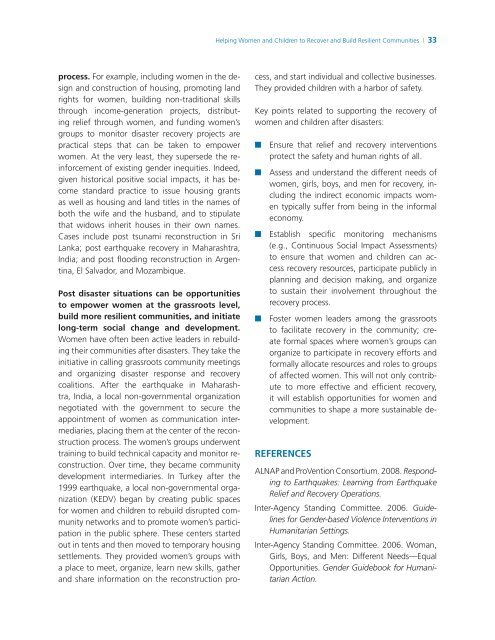Haiti Earthquake Reconstruction Knowledge Notes from ... - GFDRR
Haiti Earthquake Reconstruction Knowledge Notes from ... - GFDRR
Haiti Earthquake Reconstruction Knowledge Notes from ... - GFDRR
You also want an ePaper? Increase the reach of your titles
YUMPU automatically turns print PDFs into web optimized ePapers that Google loves.
Helping Women and Children to Recover and Build Resilient Communities | 33<br />
process. For example, including women in the design<br />
and construction of housing, promoting land<br />
rights for women, building non-traditional skills<br />
through income-generation projects, distributing<br />
relief through women, and funding women’s<br />
groups to monitor disaster recovery projects are<br />
practical steps that can be taken to empower<br />
women. At the very least, they supersede the reinforcement<br />
of existing gender inequities. Indeed,<br />
given historical positive social impacts, it has become<br />
standard practice to issue housing grants<br />
as well as housing and land titles in the names of<br />
both the wife and the husband, and to stipulate<br />
that widows inherit houses in their own names.<br />
Cases include post tsunami reconstruction in Sri<br />
Lanka; post earthquake recovery in Maharashtra,<br />
India; and post flooding reconstruction in Argentina,<br />
El Salvador, and Mozambique.<br />
Post disaster situations can be opportunities<br />
to empower women at the grassroots level,<br />
build more resilient communities, and initiate<br />
long-term social change and development.<br />
Women have often been active leaders in rebuilding<br />
their communities after disasters. They take the<br />
initiative in calling grassroots community meetings<br />
and organizing disaster response and recovery<br />
coalitions. After the earthquake in Maharashtra,<br />
India, a local non-governmental organization<br />
negotiated with the government to secure the<br />
appointment of women as communication intermediaries,<br />
placing them at the center of the reconstruction<br />
process. The women’s groups underwent<br />
training to build technical capacity and monitor reconstruction.<br />
Over time, they became community<br />
development intermediaries. In Turkey after the<br />
1999 earthquake, a local non-governmental organization<br />
(KEDV) began by creating public spaces<br />
for women and children to rebuild disrupted community<br />
networks and to promote women’s participation<br />
in the public sphere. These centers started<br />
out in tents and then moved to temporary housing<br />
settlements. They provided women’s groups with<br />
a place to meet, organize, learn new skills, gather<br />
and share information on the reconstruction process,<br />
and start individual and collective businesses.<br />
They provided children with a harbor of safety.<br />
Key points related to supporting the recovery of<br />
women and children after disasters:<br />
■■<br />
Ensure that relief and recovery interventions<br />
protect the safety and human rights of all.<br />
■■ Assess and understand the different needs of<br />
women, girls, boys, and men for recovery, including<br />
the indirect economic impacts women<br />
typically suffer <strong>from</strong> being in the informal<br />
economy.<br />
■■ Establish specific monitoring mechanisms<br />
(e.g., Continuous Social Impact Assessments)<br />
to ensure that women and children can access<br />
recovery resources, participate publicly in<br />
planning and decision making, and organize<br />
to sustain their involvement throughout the<br />
recovery process.<br />
■■ Foster women leaders among the grassroots<br />
to facilitate recovery in the community; create<br />
formal spaces where women’s groups can<br />
organize to participate in recovery efforts and<br />
formally allocate resources and roles to groups<br />
of affected women. This will not only contribute<br />
to more effective and efficient recovery,<br />
it will establish opportunities for women and<br />
communities to shape a more sustainable development.<br />
REFERENCES<br />
ALNAP and ProVention Consortium. 2008. Responding<br />
to <strong>Earthquake</strong>s: Learning <strong>from</strong> <strong>Earthquake</strong><br />
Relief and Recovery Operations.<br />
Inter-Agency Standing Committee. 2006. Guidelines<br />
for Gender-based Violence Interventions in<br />
Humanitarian Settings.<br />
Inter-Agency Standing Committee. 2006. Woman,<br />
Girls, Boys, and Men: Different Needs—Equal<br />
Opportunities. Gender Guidebook for Humanitarian<br />
Action.

















